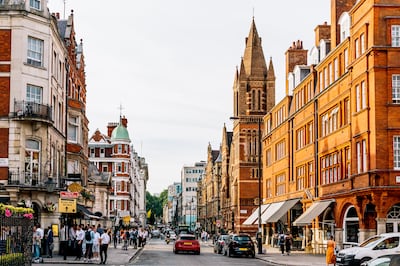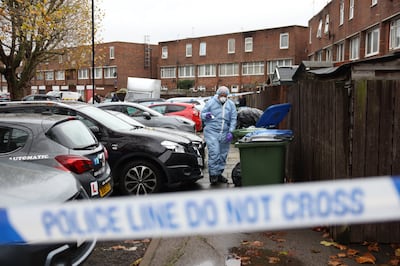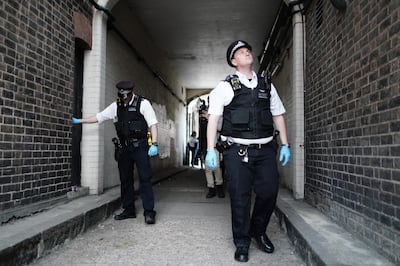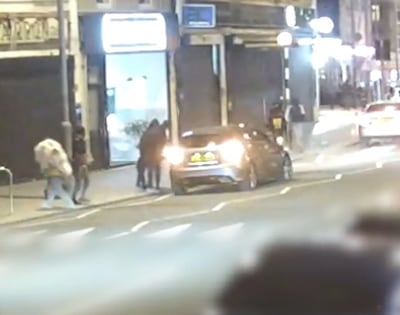Ian Rowley has a stark warning for anyone visiting central London, where he lives and also serves as a local politician.
“Don’t wear a luxury watch. It will get snatched,” he told The National.
“I don’t know anyone who wears a luxury watch, because it will get snatched.”
The representative for Marylebone High Street ward on Westminster City Council, Mr Rowley despairs not only that elegant streets in his neighbourhood are a hot spot for thefts, but that London's police force is doing so little to pursue crimes or stop them from happening in the first place.
A spate of thefts of luxury watches, often snatched by audacious gangs using mopeds to escape in broad daylight through its bustling streets, brought crime into sharp focus in the British capital.
While the Metropolitan Police set up a special task force to deal with the problem last year, anecdotal reports and figures from surveys show little respite in the fight against lawlessness.
An investigation by The National reveals how rates of theft, robbery and knife crime in central London, one of the wealthiest parts of the UK, exceed those of the rest of the city.
With London often acting as the world's window to the UK, the Met Police and mayor Sadiq Khan are under political pressure to tackle robberies and other crime that harm the city’s reputation as a safe place for visitors.
Wealthy visitors could be scared away
Gary Hersham, the founding director of Beauchamp Estates, who deals with high-end clients from the Gulf, told The National that London needs to get a grip on crime to maintain its status as a global city that's attractive to investors.
“London is competing with other wealth centres around the world to attract investment, visitors and new full and part-time residents so the provision of security for both residential and commercial property, and controlling crime, is extremely important,” he said.
“Destinations such as Monaco, Dubai, Qatar and Abu Dhabi are popular with wealthy residents and visitors because security is taken extremely seriously.

“Our offices in the Middle East and the South of France have a regular flow of people wanting to buy homes in the Gulf and Monaco respectively because in both locations security is so well regarded.
“It is essential that security provision in London keeps up with other global locations such as these.”
Hersham added that residences in places such as Kensington Palace Gardens, Eaton Square and apartments in Mayfair are popular addresses because they had on-site security and CCTV.
How bad has crime got?
Rowley represents an area of Westminster Council close to the Edgware Road area of central London, which has a large population of residents from the Middle East.
The borough is also home to many of the tourist sites that attract about 4.5 million visitors to the city and some of its wealthiest areas as well as packed, world famous shopping streets.
But according the CrimeRate database, it is also the “most dangerous” part of London, with a crime rate 215 per cent higher than the rest of the city – and 260 per cent higher than the rest of England and Wales.
In the year to April, crime increased by 32 per cent in the area compared to the previous year, with theft the most common offence, Met Police figures show.
In the same time period, robbery was up by 34 per cent and theft 66 per cent, according to the data.

Of the 3785 robberies, 1765 were of mobile phones. That compares with figures of 1,459 and 699 in the neighbouring borough of Camden.
When it comes to knife crime, the Met Police data reveals that the borough has a knife-crime rate of 3.3 per 1,000 of the population, compared to 1.5 for the whole of the city.
Knife crime went up 25 per cent in the year ending April compared with the year before and in March to April this year, it went up 12 per cent.
Criminologist James Alexander told The National the “ridiculously high” crime in central London has been partly fuelled by the economic difficulties Britain is facing.
Opportunist gangs, who have perfected their techniques, are taking advantage of the concentration of people in central London, to where they have shifted their activities and away from the suburbs, he explained.
Once a robbery has taken place “it's very hard for the police to deal with”, said Dr Alexander, from London Metropolitan University.
“I've been driving along with the police and it's impossible. You're hardly ever going to catch them.”
A Met Police spokesperson told The National that robbery victims are urged to call police within a 'Golden Hour' so officers can begin investigating immediately.
Why has knife crime become so prevalent?
The shadow of knife crime looms over London and many believe there is now a culture of carrying knives, not only by gang members, but across society as a whole. Incidents are at a 76-year high.
London currently has a rate of 50 crimes involving knives and other offensive weapons that resulted in a prison sentence or caution per 100,000 people, according to new Ministry of Justice figures. That puts the city's rate among the highest in the UK.
Knives were used in 2,480 gadget thefts in 2022, a 6 per cent increase from the year before, resulting in 180 injuries, a 35 per cent increase from the previous year, data produced by insurer Direct Line shows.
On knife crime, officers recently took part in a crack down that included seizing weapons. "Tackling violent crime continues be a priority for everyone in the Met, and our teams work tirelessly to ensure the streets of London are safe," the spokesperson said.
The horror of knives was brought home by the murder of 20-year-old Omani student Mohammed Al-Araimi, who was stabbed to death near Harrods department store by a pair of robbers.
The Ben Kinsella Trust, which campaigns to end knife crime, was founded in memory of a 16-year-old stabbed outside a London school in 2008.
Patrick Green, the charity’s chief executive, said sentencing data shows courts are still failing to tackle knife-crime offenders.
“Knife-crime offences as recorded by the police have gone up 6 per cent last year, but the number of defendants going through the courts is going down.
“You would expect if there were more offences, there would be more offenders going through court.
“We are also seeing high numbers of repeat offenders who are not getting custodial sentences.
“It appears that there a large number of people who don’t see the law as a deterrent and feel free to carry knives with impunity.”
Fear of crime
One common theme among Londoners is a fear of crime and a sense that the police have given up trying to tackle some offences.
Nearly half of Londoners say they have seen an increase in crime in their area, including that involving knives, with most believing the police can’t be relied on to deal with minor crimes, a survey carried out by the Centre for London think tank found.
“Londoners need to feel safe in their daily lives or our city simply doesn’t work,” its research director Claire Harding told The National.
“Our recent polling shows that the Metropolitan Police and policymakers still have work to do to make this a reality. Regaining the trust of all the capital’s communities is key to making London a safer city.”
Yet London continues to score highly as one of the world’s safest cities to visit and was ranked ninth in the world in research carried out by insurance company Berkshire Hathaway Travel Protect, above Sydney, Barcelona and Rome.
Away from the crime hot spots of Westminster and the neighbouring borough of Kensington and Chelsea, there is a mixed picture with one borough, Richmond upon Thames, having a crime rate 28 per cent lower than the national average.
What's being done?
Both the mayor and his political opponents set out a blizzard of statistics to make their point that crime is either coming down or soaring.
The Met Police has an ongoing campaign, Operation Venice, aimed at tackling robberies using mopeds with officers using motorbikes and marked cars to intercept suspects.
They are authorised to use what's called “tactical contact” to bump suspects off mopeds or e-bikes.

Mr Khan and the police insist London has turned a corner after the high-profile moped crimes and his office released figures to The National that show robbery citywide is down 27 per cent and knife-enabled crime down 16 per cent.
A Met Police spokesperson said the work was ongoing to combat crime in known hotspots. “We know that opportunistic criminals target areas of high footfall, such as Westminster," the spokesperson said. "To combat robberies, we have specialist teams of both uniformed officers and detectives who focus on responding effectively to reports of robbery.
"They attend calls quickly, search the area with victims and witnesses for suspects, and secure CCTV and forensic evidence."
But the opposition Conservatives accused City Hall officials of “cherry picking” data and including figures from when London was in lockdown.

While the parties squabble over the statistics, the true story of crime in London might not be getting told, with many people feeling it's not worthwhile telling the police.
Rowley said constituents have told him there's a reluctance to report crime to the police, which he believes is not attributable to any language barrier.
“The problem is that people have just given up reporting thefts because there’s a lack of police resourcing so there’s an underreporting of petty crime.
“The response rate is slow, if your phone is snatched there’s little chance of getting it back.”






